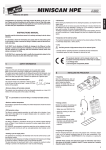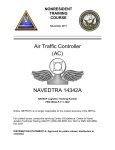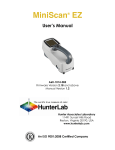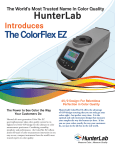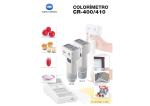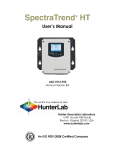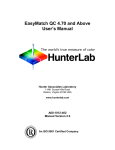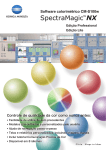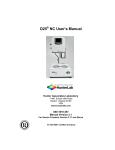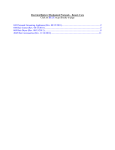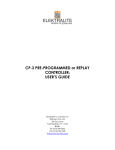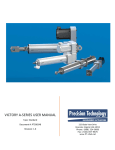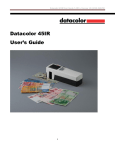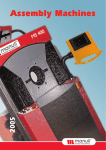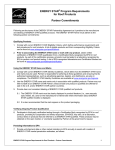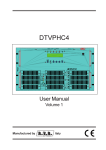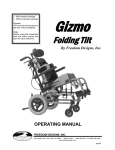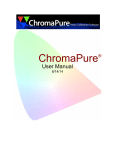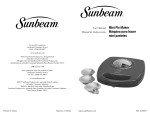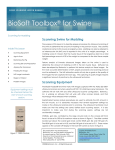Download Establishing Instrumental Color Difference Tolerances for Your
Transcript
Vol. 17, No. 12 Insight on Color Establishing Instrumental Color Difference Tolerances for Your Products Overview Color is a very important aspect of products for consumers. The appearance of a product is perceived (often correctly) to be related to its quality. This is true in almost all industries. From cookies to vinyl siding, customer buying decisions are often based on product color, making it important to bakers and extruders alike. The color of a product may be judged generally to be “acceptable” or “unsatisfactory,” or it may be judged in more detail to be “too light,” “too red,” or “too blue.” Such judgments can be made visually or instrumentally based on a perceived difference between an ideal product standard and a sample. When this difference is quantified, tolerances can be established. Tolerances are limits within which a product is considered acceptable. Any product falling outside the tolerances is unacceptable. Having good tolerances in place for each product allows you to make quick and easy pass/fail or ship/don’t ship decisions. When tolerances are established instrumentally, they may be expressed in any of the color scales or indices available with the instrument. In order to set tolerances, an ideal or close-to-ideal product standard is required, as well as a variety of products that have already been determined to be acceptable or unacceptable. There are two levels of visual color differences that are used to establish color tolerances: • Minimum perceptible difference, which defines a just-noticeable difference between standard and sample. • Maximum acceptable difference, which is the largest acceptable difference between standard and sample. Page 1 ©Copyright 2008 Applications Note Vol. 17, No. 12 Perceptible vs. Acceptable Differences Manufacturers are generally concerned about the maximum acceptable color difference rather than a minimum perceptible difference, and color tolerances are usually based on the maximum acceptable difference. Any difference larger than that would cause the sample to be rejected. In the end, agreement between the buyer and seller on acceptability criteria is necessary for establishing product color tolerances and purchasing specifications. A step-by-step process for establishing color difference tolerances is outlined in the rest of this Applications Note. Step I. Establish a Standard The first step in implementing a tolerancing program is to establish a standard that represents the ideal color for a particular product. In theory, the established manufacturing process should be capable of producing this color the majority of the time. Tolerances should be established separately for each product color, so you will need a product standard for each color. It is normal to have difference tolerances for different colors. (It is also typical to find that your tolerances must be tighter to provide acceptable results for darker colors and lower-chroma colors.) In a customer/vendor relationship, the standard representing the target color may be submitted by a designer or customer. This submission is then matched by the vendor’s manufacturing process and returned to the customer for approval. This begins the process of color communication. On the other hand, when the color evaluation is being driven by internal quality concerns, it is most effective to use a standard that represents the process average. This can be accomplished by selecting a physical specimen from the center of the population or by averaging the measured results of a group of specimens to determine a numeric mean. An example of determining a colorimetric mean is shown below. Many HunterLab products (ColorFlex, DP-9000, EasyMatch Coatings, EasyMatch OnLine, EasyMatch QC, MiniScan XE Plus, Universal Software) can automatically average samples for you. Page 2 ©Copyright 2008 Applications Note Vol. 17, No. 12 Use of the Mean for Establishing a Standard Sample ID L* a* b* 1 20.22 0.64 -11.22 2 20.70 0.66 -11.02 3 20.73 0.61 -10.99 4 20.38 0.60 -10.82 5 20.75 0.49 -10.62 6 20.37 0.50 -10.43 7 19.99 0.54 -11.20 8 20.15 0.52 -10.81 9 20.29 0.59 -10.55 10 20.48 0.57 -11.22 11 20.50 0.64 -10.72 12 19.87 0.70 -11.02 13 20.81 0.59 -11.22 14 20.31 0.53 -11.18 15 20.56 0.61 -10.57 Average 20.41 0.59 -10.91 Care should be taken to preserve the color of physical standards by minimizing the influence of light, temperature, contamination, and other aging factors. A system may be established whereby duplicate standards are created and stored until needed. The amount of change in a current, or “working,” standard over time can be determined by comparing it to a stored, and theoretically pristine, duplicate. If an instrument is being used to measure color, the current instrumental reading for the standard can be compared to the previously assigned values. As suggested by the SAE J1545 Recommended Practice, if a working standard has deviated by the greater of 0.2 color difference units in ∆L*∆a*∆b* or ∆L*∆C*∆H* or 0.1 times the tolerance range, the standard should be carefully evaluated and possibly replaced with a back-up. The worksheet below details an example evaluation of such a standard. Page 3 ©Copyright 2008 Applications Note Vol. 17, No. 12 Verifying a Physical Standard Color Scale Tolerances Pass/Fail Criteria Assigned Values Current Values Difference (Delta) L* ±0.50 0.20 24.81 24.87 0.06 PASS a* ±0.40 0.20 -5.16 -5.18 -0.02 PASS b* ±0.30 0.20 -4.61 -4.43 0.18 PASS This standard does not need to be replaced. Step II. Visually Evaluate Pass/Fail Once the product standard is established, a “pass” or “fail” rating can be assigned visually to any specimen that is compared to that standard. Results should be reported in a fashion similar to those shown below, including complete information on the particular conditions under which the specimens were evaluated. Visual Pass/Fail Data Date: 4/12/05 Operator: KSS Apparatus: Light Booth Lamp: Daylight Product: PF11280-408 Standard: 11280 Specimen ID Pass/Fail Indication 11287 Pass 11295 Pass 11211 Pass 11213 Pass 11213 Pass 11220 Pass 11241 Pass 11242 Pass 11264 Pass 11266 Fail 11272 Fail 11395 Fail 11411 Pass 11415 Fail Page 4 ©Copyright 2008 Applications Note Vol. 17, No. 12 Visual Pass/Fail Data Date: 4/12/05 Operator: KSS Apparatus: Light Booth Lamp: Daylight Product: PF11280-408 Standard: 11280 Specimen ID Pass/Fail Indication 11111 Fail Since specimens may vary from the target color in terms of lightness, redness/greenness, or yellowness/blueness, it may be helpful to employ physical standards which deviate along the tolerance perimeters for these three axes. An example of this type of tolerancing arrangement is shown below. Visual Deviations from Target in Lightness/Darkness, Red/Green, and Blue/Yellow To be useful, these visual evaluations must be as repeatable and reproducible as possible. The parameters listed below must be carefully controlled. Similar parameters are listed in ASTM Standard D1729. A light booth can be a useful tool for establishing a standard light source (such as incandescent, fluorescent, or daylight), angle of illumination, and angle of viewing. Conditions to be Controlled for Visual Evaluation 1. Spectral quality of the light source 2. Intensity of the light source 3. Angular size of the light source 4. Angle of incidence (the angle from which light strikes the object) 5. Angle of viewing (the angle at which the object is viewed) 6. Background color. Page 5 ©Copyright 2008 Applications Note Vol. 17, No. 12 Step III. Make Instrumental Measurements Modern color measuring instruments (spectrophotometers and colorimeters) use the CIE colorimetric mathematical model to relate the human perception of color to instrumental response. Colorimetric scales such as CIE L*a*b* and CIE L*C*h can be derived from this mathematical model to serve as useful tools in communicating and quantifying color and appearance. The numbers obtained describe the nature and magnitude of the difference in color between standard and sample in a way that is meaningful to a human observer. Instruments not only provide an objective, numerical measurement system, but they can also often discriminate or “see” small color differences better than the average human observer and can do so repeatably. In other words, instruments are more accurate and more repeatable than humans. Another recognized advantage to using instrumentation is the agreement on specimen readings between different instruments, which is better than the agreement between visual assessments by two different human observers. This function, known as reproducibility, easily expands the capability for communication of color between different manufacturing facilities. When comparing results for different specimens measured on different instruments, specific sample handling techniques and instrumental settings should be defined and used. Adherence to a defined method will reduce the error associated with sample presentation and instrumentation. Some of the parameters to be considered and standardized in test method development are listed below. Criteria for Color Measurement Methodology • Instrument geometry: 45°/0° or diffuse/8° (sphere) • Sample preparation, including taking opacity, translucency, etc. into account • Sample presentation, including instrument port size, etc. • Color scale or color difference scale • Illuminant • Standard observer • Standardization mode • Sample averaging. The recommended practices of various professional trade associations (such as ASTM, TAPPI, and AATCC) are available in the literature. When comparing measurements made on different instruments, the best results are obtained for color differences when the instrument group contains units of similar geometrical design. For instance, it would not be advisable to compare results obtained on a 45°/0° instrument to those obtained using a diffuse/8° instrument. For recommendations of ways to maximize inter-instrument agreement, refer to the Applications Note titled “Maximizing Inter-instrument Agreement.” When it is important that two or more instruments of similar design read the “same” values for a group of specimens, the technique of hitch standardization may be employed. This process involves naming one instrument as the reference, or “master,” unit and mathematically adjusting the secondary, or “slave,” units to match. In this way, two or more instruments can be “hitched” together. For more information on this process, see the Applications Note titled “HunterLab’s Guide to Hitch Standardization.” Page 6 ©Copyright 2008 Applications Note Vol. 17, No. 12 Instrument diagnostics provided by the instrument manufacturer should be run on a regular basis. Adherence to a schedule will ensure confidence in the measurements and allow early detection of instrumental problems. Once the instrument and method are in place, it is time to gather and read a group of samples. To be most effective, this group should be large enough to provide some statistical credibility (i.e., twenty or more samples) and should include samples that pass, as well as samples that fail when visually rated. Specimens that are unacceptable assist in finding the numerical tolerance boundaries. To verify and refine the initial product tolerances, expand the data base by collecting more samples. Next, rate the acceptability (in terms of pass or fail) of each sample by visually comparing it to the physical product standard as described in Step II (if you haven’t already). Then, measure each of these samples on the instrument and determine its color difference relative to the product standard. And example data summary is shown below. Visual and Instrumental Data 1 2 3 4 5 6 Sample Number Specimen ID Visual Pass/Fail ∆L* ∆a* ∆b* 1 11287 Pass 0.23 0.01 0.09 2 11295 Pass 0.46 0.03 -0.08 3 11211 Pass -0.15 0.12 0.05 4 11213 Pass -0.01 -0.07 0.04 5 11216 Pass -0.03 -0.14 0.18 6 11220 Pass 0.12 0.09 0.15 7 11241 Pass -0.20 -0.18 -0.11 8 11242 Pass -0.37 0.15 -0.23 9 11259 Pass -0.49 -0.19 0.02 10 11264 Pass 0.46 0.13 0.15 11 11266 Fail 0.56 0.26 0.30 12 11272 Fail -0.61 -0.24 0.04 13 11395 Fail -0.78 -0.27 -0.21 14 11411 Pass -0.34 -0.04 0.16 15 11415 Fail -0.86 -0.45 -0.17 16 11111 Fail 1.25 0.44 0.25 Page 7 ©Copyright 2008 Applications Note Vol. 17, No. 12 Step IV. Establish the Tolerances There are several types of tolerances you may establish and several methods for doing so, which are outlined below. Tolerance Type 1: Rectangular Tolerances Rectangular tolerances are the simplest type of tolerances and are shown in a form similar to the example given below. All three components of the color scale (such as L*, a*, and b* or L, a, and b) should be toleranced. Color Tolerances for the RED 3645 Standard L* (D65/10°) 43.48 ± 0.50 a* (D65/10°) 45.45 ± 0.50 b* (D65/10°) 27.15 ± 0.50 These tolerances are “rectangular,” because when plotted on a color plot, they are expressed as a rectangle. L* tolerance b* tolerance a* tolerance Sometimes 0.2 CIE L*a*b* units is quoted as an “approximate visual difference limit,” so it may be tempting to use such a number for your rectangular tolerances. In general, however, tolerances should be based on visual assessment using measurements of acceptable and unacceptable samples and an “ideal” product standard, as the 0.2 unit difference will likely be too tight for most applications, resulting in discard or rework of product that might actually have been acceptable to the customer. Rectangular tolerances may be established using Tolerance Method 1, Method 2, or even Method 3b described below. Tolerance Type 2: Single-Number Tolerances If your customer cares only about one component of the color scale (such as L, or lightness), or asks for readings only in a particular index (such as Yellowness Index), it is acceptable to establish a tolerance only for the parameter of interest. This tolerance may be established using Method 1, Method 2, or even Method 3b (if the parameter of interest is a component of the color scale). An example single-number tolerance is shown below. Page 8 ©Copyright 2008 Applications Note Vol. 17, No. 12 Color Tolerance for the WHITE BASE Standard YI E313 (C/2°) <5 units A word of caution, however, concerning total color difference values. It is not wise to use ∆E or ∆E* alone as a tolerance if all the components of the color scale are truly of interest. This is because, although the product may be perfectly acceptable when the color difference is spread out over all three dimensions (L, a, and b or L*, a*, and b*), if the difference is concentrated on one of the dimensions, it may be obviously unacceptable. For example, if a given tolerance is 1 ∆E (Hunter L, a, b) unit, the difference could be 0.57 for L, 0.57 for a, and 0.57 for b, and would probably be acceptable visually. ∆E = 0.57 2 + 0.57 2 + 0.57 2 = 1 . However, if the sample is perfect for L and b but off (yet within the ∆E tolerance) for a, the sample looks very unacceptable. ∆E = 0.0 2 + 1.0 2 + 0.0 2 = 1 . This caution does not apply to the ∆E values used in elliptical tolerancing (such as ∆E CMC), as the elliptical tolerancing systems are designed specifically to provide a single-number total color difference tolerance. See the next section for information on how the elliptical scales can be used to help you set pass/fail tolerances. Tolerance Type 3: Elliptical Tolerances The following general rules apply to human assessments of color: • Hue (h) differences are most objectionable. • Humans will tolerate a little more difference in chroma (C*) than in hue (h). • Humans will tolerate lightness (L*) differences more easily than differences in chroma (C*) or hue (h). These principles form the basis for elliptical tolerancing. The elliptical tolerancing scales are CMC, CIE94, DIN99, and CIE2000 (all available in EasyMatch QC and EasyMatch OnLine; consult your User’s Manual for availability with other products), and they operate on the principle that the limit of the region of color space surrounding a product standard for which color differences are not visually detectable forms an ellipsoid with axes in the direction of lightness (l), chroma (c), and hue (h). Page 9 ©Copyright 2008 Applications Note Vol. 17, No. 12 The CMC Ellipsoid The Product Standard The overall volume (size) of the ellipse is the overall color tolerance. For the default commercial factor of one (called cf for CMC, DIN99, and CIE2000, kv for CIE94), this volume equals one ∆E unit of the elliptical scale of interest, or one just-visible-difference unit. This volume may be adjusted in order to tighten or loosen the overall tolerance. The lightness:chroma ratio (called l:c for CMC, kl:kc for CIE94, ke:kch for DIN99, and KL:KC for CIE2000) sets the shape of the ellipsoid along the lightness-chroma axis. The default of 2:1 used in the textile industry makes the ellipse twice as long in the lightness direction as it is wide in the chroma direction. If your product or your customer is more or less sensitive to lightness differences than usual, you may lower or raise this ratio accordingly. The table below indicates the l:c ratios typically used within particular industries. Industry Typical lightness:chroma Ratio Coatings 1:1 Plastics 1.3:1 Textiles 2:1 More information on how to implement elliptical tolerances is given in Tolerance Method 3a. Tolerance Method 1: Determining Tolerances Using a Graph To demonstrate this method of establishing tolerances, we will create a graph for each of the difference values listed in the table in Step III (page 7). As an example, we will plot the lightness/darkness (L*) differences. The y-axis will contain the color difference values (column 4) and the x-axis will contain the sample number (column 1). The plot is shown below. Note: Some HunterLab software products can create this graph for you. Look for a “trend plot” or “control chart” view. Page 10 ©Copyright 2008 Applications Note Vol. 17, No. 12 Sample Number Versus ∆L* Next, add the visual pass/fail data by labeling each sample as passing (no label) or failing (labeled with an “F”) using the table’s column 3. As shown below, upper and lower boundary lines can then be drawn to separate the graph into three areas. The lower rectangle (below the lower red line) represents all the samples that fall outside the lower tolerance (i.e., are too dark), the middle rectangle (between the red lines) represents all samples which are acceptable for L*, and the upper rectangle (above the upper red line) represents all the samples that fall outside the upper tolerance (i.e., are too light.) You can see that both the upper and lower L* limits occur at about 0.5 L* from the standard. ±0.5 would be used as your starting tolerance. Pass/Fail Labels and Tolerance Limits Next, you should make a similar graph for the remaining color difference parameters, a* and b*, using columns 1 and 5 and 1 and 6, respectively, of the data table. Using this graphing technique, twenty well-chosen samples will provide a good set of starting tolerances. Data on future specimens should be added to the graph to check the ongoing validity of the specifications. As the sampling number approaches 50 or more, confidence in the tolerances should greatly increase. Page 11 ©Copyright 2008 Applications Note Vol. 17, No. 12 Tolerance Method 2: Determining Tolerances Using Statistics Much of the data obtained in an ongoing production process will assume the shape of a bell curve when plotted as a frequency polygon. This shape is more commonly referred to as the normal distribution curve and is useful when studying color difference values. Certain statistical assumptions can be made about the normal curve that are useful in describing the population. One of these statistical properties, the standard deviation, helps to describe the distribution of the measurements about the average, or population mean. MEAN FREQUENCY STANDARD DEVIATIONS The Normal Distribution Curve Color difference measurements are plotted on the x-axis and their corresponding frequencies are plotted on the y-axis. The x-axis can be divided into equal parts called standard deviation or sigma (σ) units. The value given to the standard deviation at the center of the curve represents 100% of the measurement in question. For each standard deviation, a portion of the total area is represented. At the level of ±3σ, approximately 99.7% of the population is covered. Population Distributions for the Normal Curve It is generally agreed that tolerance limits can be set at the ±3σ level over the process range for acceptable values. This concept is based on statistical process control (SPC) studies. Page 12 ©Copyright 2008 Applications Note Vol. 17, No. 12 Process capability is the degree to which a process is consistently able to manufacture product within established specifications. “Process” refers to the product variables being measured, such as color, as well as the procedures, the machinery, and the workmanship involved. Results are usually expressed as the proportion or percent of product that will be within the tolerance. Process capability studies are SPC techniques which are valid only after statistical control has been determined and established. For the purposes of this Applications Note, a discussion of SPC will not be provided. However, more information can be found in the literature referenced in the bibliography. In practical terms, a process that is not “in control” and is constantly shifting does not lend itself well to fixed tolerance limits. Process capability studies are needed to set tolerances, as well as to evaluate current specifications. The accepted criterion for long-term process capability is that the process function is 99.7% within specification. This 99.7% refers to the ±3σ level. To determine the upper and lower tolerance limits statistically, complete the following steps: 1. Collect data on a group of samples, including visual pass/fail information and instrumental measurements (as described in Steps II and III). Determine the mean colorimetric values and, using this mean as a standard, calculate the color difference between this standard and all the samples as shown below. Colorimetric Data on Cracker Production 1 2 3 4 5 6 7 8 Sample Number Specimen ID L* ∆L* a* ∆a* b* ∆b* 1 GG 50.95 -6.40 15.46 2.94 37.37 -3.50 2 AA 51.21 -6.14 15.54 3.02 38.75 -2.12 3 NN 52.28 -5.07 14.88 2.36 37.75 -3.12 4 MM 53.01 -4.34 14.29 1.77 37.45 -3.42 5 OO 54.01 -3.34 14.52 2.00 41.44 0.57 6 PP 54.15 -3.20 14.74 2.22 40.23 -0.64 7 BB 54.89 -2.46 13.72 1.20 39.52 -1.35 8 B1 54.98 -2.37 14.07 1.55 41.92 1.05 9 RR 55.27 -2.08 13.46 0.94 39.99 -0.88 10 QQ 55.72 -1.63 13.82 1.30 41.24 0.37 11 JJ 56.32 -1.03 13.15 0.63 40.62 -0.25 12 SS 56.90 -0.45 13.22 0.70 40.04 -0.83 13 KK 57.02 -0.33 12.86 0.34 40.39 -0.48 14 TT 57.05 -0.30 12.53 0.01 39.53 -1.34 15 DD 57.10 -0.25 13.00 0.48 41.91 1.04 Page 13 ©Copyright 2008 Applications Note Vol. 17, No. 12 Colorimetric Data on Cracker Production 1 2 3 4 5 6 7 8 Sample Number Specimen ID L* ∆L* a* ∆a* b* ∆b* 16 II 57.12 -0.23 13.16 0.64 40.75 -0.12 17 VV 57.61 0.26 12.67 0.15 43.72 2.85 18 CC 57.71 0.36 12.74 0.22 41.08 0.21 19 EE 58.19 0.84 12.18 -0.34 41.42 0.55 20 HH 59.14 1.79 11.99 -0.53 41.30 0.43 21 ZZ 59.26 1.91 11.86 -0.66 41.01 0.14 22 LL 59.98 2.63 11.16 -1.36 40.82 -0.05 23 C1 60.08 2.73 11.08 -1.44 43.46 2.59 24 YY 61.10 3.75 10.33 -2.19 43.49 2.62 25 WW 62.65 5.30 9.09 -3.43 42.14 1.27 26 XX 64.01 6.66 8.41 -4.11 42.37 1.50 27 A1 64.07 6.72 8.22 -4.30 42.17 1.30 28 UU 64.10 6.75 8.45 -4.07 42.48 1.61 Mean (Standard) 57.35 12.52 40.87 2. Determine the standard deviation for each color difference parameter and summarize the data as shown below. Summary Statistics for Crackers L* Number of Samples 28 a* 28 b* 28 Minimum Value 50.95 8.22 37.37 Maximum Value 64.10 15.54 43.72 Range 13.15 7.32 6.35 Mean 57.35 12.52 40.87 Standard Deviation 3.67 2.08 1.69 3. Then, assuming a normal distribution, plot the data for each colorimetric value (Microsoft Excel can do this) and view the shape of the distribution and the location of the 3σ level. An example for ∆L* is shown below. Page 14 ©Copyright 2008 Applications Note Vol. 17, No. 12 dL* Distribution 20 15 Count 10 5 0 -15 -10 -3σ -5 0 5 -5 dL* 10 15 3σ 4. Assume that the desired specification limits are equal to ±3σ and find the tolerance limits for each color scale parameter using the following equations. The example shown is for L*. For absolute tolerances: Lower Limit = -3σ + Mean Lower Limit = (-3*3.67) + 57.35 Lower Limit = 46.34 Upper Limit = 3σ + Mean Upper Limit = (3*3.67) + 57.35 Upper Limit = 68.36 For difference tolerances (recommended): Lower Difference Limit = -3σ Lower Difference Limit = -3*3.67 Lower Difference Limit = -11.01 Upper Difference Limit = 3σ Upper Difference Limit = 3*3.67 Upper Difference Limit = 11.01 As additional samples are read, they should be added to the distribution plot to test the effectiveness of the 3σ tolerances. If the ends of the 3σ range begin to include out-of-specification product, the tolerance should be recalculated to reduce the range and the standard deviation of the in-tolerance samples. This will better exclude the out-of-tolerance samples from the specification. Another approach to solidifying tolerances is to assess the capability of the process to manufacture product within the set specifications. Information on completing a process capability study is available in the literature and involves using a formula similar to the one already presented. The aim would be to substitute in the current tolerances and solve for the number of standard deviations needed to include the in-tolerance samples. The result would predict the percentage of the population that could be produced within tolerance using the current manufacturing process and specifications. Page 15 ©Copyright 2008 Applications Note Vol. 17, No. 12 Tolerance Method 3a: Using Elliptical Tolerances This section describes how to actually implement the elliptical tolerances described in Tolerance Type 3. Ellipsoidal volumes are thought to more accurately describe human perceptibility limits than rectangular tolerance boxes. By definition, any sample that falls within the ellipsoid (and the ∆E limit chosen for the scale being used) is acceptable for the standard at its center and any sample that is outside the ellipsoid (and the ∆E limit chosen for the scale being used) is unacceptable. Thus, assigning tolerances for a product standard using elliptical tolerancing is as simple as reading the standard, choosing the elliptical scale for use, and setting the lightness: chroma ratio and commercial factor (beginning with industry defaults and adjusting as needed using read samples). Then, samples outside the ∆E limit will fail and samples inside the ∆E limit will pass. Refer to your User’s Manual for more information on elliptical tolerances. Tolerance Method 3b: Using Automatic Tolerancing In HunterLab’s EasyMatch QC, CMC autotolerancing can be used to automatically fit a CMC ellipsoid to a standard and to calculate CIE L*a*b*, CIEL*C*h, or Hunter L, a, b rectangular tolerances for that standard based on the size and shape of the ellipsoid. Once the ideal product standard is read, the parameters for the automatic tolerancing can be set through the software, as follows: • Color Scale: scale under which you would like the automatically-generated tolerances to be expressed (CIE L*a*b*, CIEL*C*h, or Hunter L, a, b) • Illuminant/Observer: illuminant/observer combination under which you would like the automatically-generated tolerances to be expressed • l:c ratio: as described in Tolerance Method 3a. • Commercial factor: as described in Tolerance Method 3a. • Auto tolerance Correction factor: the 0.75 default value in EasyMatch QC estimates the percentage of the tolerance box that is taken up by the CMC ellipsoid (excluding the 25% of the box volume that does not overlap with the ellipsoid). This value may be adjusted to tighten or loosen the tolerance, as desired. A value of one would use the entire volume of the tolerance box, including those areas outside the CMC ellipsoid, as shown below. The elliptical tolerances The rectangular tolerances Example of an area of the tolerance box outside (and not overlapping with) the ellipsoid Page 16 ©Copyright 2008 Applications Note Vol. 17, No. 12 After all parameters are set, the rectangular tolerances are automatically generated and used by the software for samples that are compared to this product standard. Refer to the EasyMatch QC User’s Manual for more information on using the automatic tolerancing feature of that software package. CMC autotolerancing can also be used within HunterLab’s ColorFlex and MiniScan XE Plus firmware to automatically fit a CMC ellipsoid to a standard and to calculate ∆L*∆C*∆H* rectangular tolerances for that standard based on the size and shape of the ellipsoid. In the product setup select the L*a*b* color scale, ∆L* ∆C* ∆H* color difference scale, and ∆Ec index difference. Enter the desired commercial factor (cf) and the l:c ratio as described in Tolerance Method 3a. You must also select a “PHYSICAL” type standard and read your product standard into the setup. After the standard is read, the automatically-generated ∆L*, ∆C*, ∆H* tolerances are entered into and used with this product setup unless they are manually altered or another product standard is read into this setup. Refer to your ColorFlex or MiniScan XE Plus User’s Guide for more information on using the automatic tolerancing feature of the instrument. Bibliography AATCC Test Method 173, “CMC: Calculation of Small Color Differences for Acceptability,” American Association of Textile Chemists and Colorists, Research Triangle Park, North Carolina, www.aatcc.org. ASTM D1729, “Standard Practice for Visual Appraisal of Colors and Color Differences of DiffuselyIlluminated Opaque Materials,” ASTM International, West Conshohocken, Pennsylvania, www.astm.org. ASTM D3134, “Standard Practice for Establishing Color and Gloss Tolerances,” ASTM International, West Conshohocken, Pennsylvania, www.astm.org. Hunter, Richard S. and Harold, Richard W., The Measurement of Appearance, New York: John Wiley & Sons, 1987, www.hunterlab.com. “HunterLab’s Guide to Hitch Standardization,” Applications Note, HunterLab, September 1998. “Maximizing Inter-instrument Agreement,” Applications Note, HunterLab, June 2005. Recommended Practice J1545, “Instrumental Color Difference Measurement for Exterior Finishes, Textiles, and Colored Trim,” SAE International, Warrendale, Pennsylvania, www.sae.org. For Additional Information Contact: Technical Services Department Hunter Associates Laboratory, Inc. 11491 Sunset Hills Road Reston, Virginia 20190 Telephone: 703-471-6870 FAX: 703-471-4237 www.hunterlab.com 03/08 Page 17 ©Copyright 2008

















